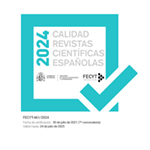CALL for PAPERS para los próximos números 14/2, 15/1 y 15/2
Tema monográfico del nº 15/1 (2026-1)
Las casas de cristianos, musulmanes y judíos en el siglo XV
Editoras invitadas: María Elena Díez Jorge y Christine Mazzoli Guintard
Fecha límite: 15 de noviembre de 2025
Con este monográfico se pretende avanzar en el conocimiento de las casas del ámbito hispano teniendo en cuenta los diferentes modos de vida que en el siglo XV confluyeron en la península ibérica. La documentación sobre descripciones de casas, así como de sus enseres, nos muestra un mundo complejo con aderezos calificados en ocasiones con maneras culturales (a la morisca, turquesco, a la castellana…). No siempre coincidía que un ajuar calificado a la morisca estuviera en casa de un musulmán o un converso, ya que, por ejemplo, era muy frecuente que enseres calificados de moriscos estuvieran en viviendas de cristianos viejos. No obstante, el hecho de que los habitantes de una casa fueran de una u otra procedencia cultural y tuvieran un modo de vida especial creaba una cierta atmósfera, que impregnaba el interior de ese hogar. Hubo diferencias culturales, pero también ciertos traspasos y similitudes, que nos permiten hablar, más que de tres culturas, de una misma, pero poliédrica. El estudio de la casa a través de los textos e imágenes de manera conjunta nos ofrece una herramienta imprescindible para el acercamiento a las respectivas comunidades emocionales y a las distintas caras de ese poliedro cultural del XV, que nos brindan las palabras y la cultura material de sus viviendas. Esta propuesta parte de la necesidad metodológica de comprender de manera integral la casa en el contexto hispano durante el siglo XV. Arquitectura, distribución espacial, articulación familiar, enseres y vivencias emocionales, todos estos factores jugaron un importante papel, teniendo en cuenta que la compleja sociedad del período englobaba viviendas con modos de vida a priori diversos, pero en ocasiones con aspectos poco diferenciadores en la práctica.
Tema monográfico del número 15/2 (2026-2)
Una Edad Media cromática
Editores invitados: Ana María Cuesta Sánchez y Ángel Pazos-López
Fecha límite: 30 de abril de 2026
En los últimos años la investigación de la realidad cromática en la Edad Media ha recibido una atención creciente por parte de especialistas de diferentes disciplinas académicas. Afortunadamente, la visión de una Edad Media oscura y monocroma –propagada por la historiografía decimonónica– se va desterrando del imaginario colectivo gracias a importantes acciones de transferencia de conocimiento científico en los medios de comunicación, libros divulgativos y creaciones de ficción. Un gran número de las obras de arte medieval que se conservan hoy en día en museos, catedrales o iglesias nos aportan importantes datos sobre la composición técnica o los procesos de creación material asociados a los colores. Asimismo, la comprensión de las diferentes dimensiones de los colores medievales posee implicaciones que van más allá de lo puramente material y están conectadas con la experiencia sensorial de los hombres medievales.
Para ello, se proponen una serie de líneas temáticas en torno a las que pueden girar las aportaciones de los investigadores:
La dimensión material de los colores medievales, evocada a través del estudio de los pigmentos, materiales, tintes y elementos cromáticos que servían para dar color a diferentes artefactos y obras.
La dimensión artística y documental de los colores medievales, rastreable a través de las fuentes documentales, los tratados, los libros de artista, así como las pruebas de los usos cromáticos en la diversidad de las artes.
La dimensión técnica de los colores medievales, materializada en la pluralidad de usos en numerosos medios y soportes artísticos, como los manuscritos iluminados, la policromía en piedra, madera, panel o lienzo, así como el estudio del color en la diversidad de las artes suntuarias, como las vidrieras, los esmaltes, la cerámica, los mosaicos o los tejidos.
La dimensión simbólica de los colores medievales, reflejada en los usos y valores sociales y extrasemánticos conferidos al cromatismo de los espacios, ropas y objetos de uso cotidiano o festivo, tanto en el espacio sagrado como en el entorno cotidiano o cortesano.










